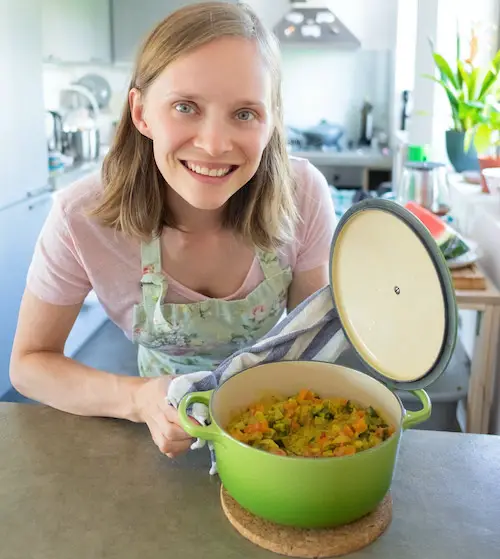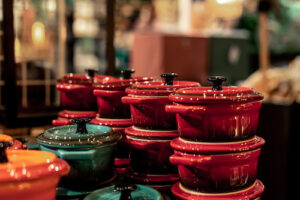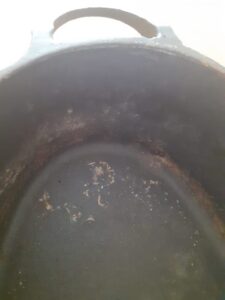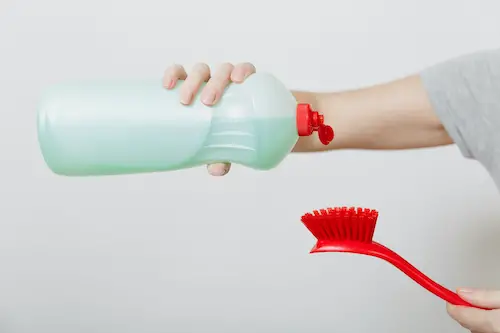This post contains affiliate links. When you buy through our links, we may earn a commission.

How to Care for Your Dutch Oven – A Comprehensive Care Guide for Avid Cooks
If you are looking for an all-in-one dish, a Dutch oven is the way to go. It is an ingenious piece of cooking equipment that can bake bread and cakes, cook seafood and meat, and whip up one-pot wonders such as stews and curries.
Enjoy tender vegetables and fall of the bone meat dishes with this fabulous cookware.
However, it is imperative to follow careful maintenance and care tips to keep a Dutch oven in prim shape.
Look at the information below to find out how to care for your Dutch Oven and more.
What is a Dutch Oven?
 A Dutch oven is a wonderful vessel that is a must-have in any kitchen. This versatile kitchen tool is a heavy-based and thick-walled pot. It also has an equally heavy fitted lid, ensuring an evenly cooked meal.
A Dutch oven is a wonderful vessel that is a must-have in any kitchen. This versatile kitchen tool is a heavy-based and thick-walled pot. It also has an equally heavy fitted lid, ensuring an evenly cooked meal.
These ovens are usually made from cast iron, cast aluminum, or ceramic materials. Some come with pre-seasoned enamel, with others requiring a coat of ‘fat’ as the season before cooking.
Cast iron has many benefits! It retains heat and handles extreme temperatures well. Dutch ovens work well on conventional stovetops, grills, and ovens without fear of damaging this beautiful pot.
If you love camping, having this pot is a bonus. The cast-iron variant works well on wood and coal stoves too.
Did you know that you can use this vessel to keep food chilled ahead of time, and it will keep cool until needed? That’s an amazing kitchen aid to own!
However, these ovens are generally not non-stick pans, so ‘dry cooking‘ is not ideal. It is recommended to grease the bottom of the pan with a bit of liquid or oil before cooking.
The tight-fitting lid creates and traps steam, heat, and a self-basting system, ensuring an even cook and tender meat and vegetables. You can look forward to mouth-watering meals every time.
How to Care for a Dutch Oven?
 It is imperative to take good care of the Dutch Oven, especially if yours is seasoned with enamel.
It is imperative to take good care of the Dutch Oven, especially if yours is seasoned with enamel.
Famous brands such as Le Creuset are seasoned well with an enamel coating; however, if yours is not, a proper seasoning of lard or olive oil will ensure durability, no rusting, and, over time, create a gorgeous nonstick coating.
As with all good things, seasoning the pan takes time. To do this, massage your choice of lard or oil into the pot.
Pop the pan into a heated oven at 400 degrees Fahrenheit for an hour, then switch it off and leave it to cool in the Oven.
Seasoning is created with proper use and care over time, as it is not a once-off task. It should be done every so often, especially after using dishwasher soap to clean it.
Washing a Dutch Oven

Washing and caring for your pot depends solely on your chosen type of Dutch Oven.
If your pot is enamel coated, warm soapy water and a nylon brush will easily clean off food particles.
Should your Dutch oven be seasoned with fat, one should be cautious in protecting the seasoning.
Follow these vital tips:
► It is recommended to scrape off food particles with non-abrasive utensils such as a spatula and then wipe it off clean with a damp cloth.
► A useful trick to clean without using soap is a salt and hot water mixture. However, remember never soak cast iron Dutch ovens and never shock your pans with unexpected extreme temperatures. They should gently heat or cool, so placing a hot pot in cold water is a big No! Also, cast iron pots must be kept completely dry, so no rust develops in the pan.
► Another helpful way to clean out very stubborn greasy messes is to leave the pot on the stovetop, pour in water an inch high, and give it a quick boil. It will help loosen food particles so you can scrape them off easily. Next, drain the water and wash with a nylon brush. Be sure to use nylon utensils when cooking and scrapping.
► Spread a few drops of oil into the pan whenever soap is used to clean thick, messy grease. It will ensure a thoroughly protected pan.
► The more you use your cast iron Dutch Oven, the seasoning will enhance into a thick non-stick barrier. It will make your cooking and cleaning venture a breeze as time goes by.
If you are looking for a beautiful gift to pass down from generation to generation, this is an awesome investment.
Why not welcome the newest family member with hand-written, age-old filter recipes when passing it down? I am sure that it would be appreciated.
Conclusion
Dutch ovens are beautiful and versatile cookware suitable for any kitchen. With the correct care and treatment, they will last for many lifetimes to come.
Seasoning the pan and making an informed decision will ensure maximum benefit when purchasing one.
Harsh soaps and detergents are not recommended for use in the pan, but rather a natural cleaning agent like salt is preferred.
Oiling the pan will ensure a long-lasting nonstick Dutch oven. It is the ideal investment for any kitchen.
Frequently Asked Questions (FAQ)
Do I need to pre-heat the Dutch Oven to bake?
No, it is not recommended nor required to preheat. Depending on the type of Dutch Oven you own, pre-heating an empty pot may cause it to crack.
Can I use any dishwasher soap to clean it?
It is not advised as there are other methods to clean it. However, should a greasy mess require soap, you may use a mild dishwashing soap. Be sure to spread a few drops of oil into the pan after thoroughly drying it.
Can I deep fry food in my cast-iron Dutch pan?
Yes, you most definitely can! Several people enjoy their fried foods that are made in cast-iron Dutch pans.
Can I cook on a coal stove?
Yes, the Dutch Oven is great for wood and coal stoves too.
Why is my food burning in my Dutch Oven?
One reason could be that the pan is too hot with insufficient oil while cooking. The pan might also not be seasoned well.
Can I cook acidic dishes in my Dutch Oven?
Yes, Dutch ovens are non-reactive and non-toxic, so it is perfectly safe to cook acidic food.
Which is the best type of utensils to use in my Dutch Oven?
Ideally, wooden, silicone, or nylon are the best utensils to use with your Dutch Oven. Metal variants will risk scraping the surfaces or walls of the pan.
Is there anything I shouldn't cook in the Dutch Oven?
It is advised that delicate food like flaky fish or eggs be avoided. Also, to be able to cook sticky foods like desserts and sticky sugar syrups, one must ensure a thorough seasoning of the pan.
Can I use my enamel-coated Dutch Oven from fridge to Oven?
Yes, provided you allow it to adjust to room temperature. A thermal shock with two extreme temperatures will cause the pan to crack.
Can I put my cast iron Dutch Oven in the dishwasher?
No, this will ruin the pan as well as the seasoning.
Can I soak a Dutch oven in water?
No, this will create moisture in the pan and break down the seasoning.
My enamel Dutch Oven has a chip, can I use it?
It would depend on where the chip is located. If the chip is on the cooking surface, the answer is no. The chip may continue and spread, causing pieces of enamel to land in your food.
Can I save my rusty cast iron Dutch Oven?
Yes, by mixing equal parts of white vinegar and water and submerging in the rusty pieces, then giving it a complete wash and dry, your pan should be good to go. Don't forget to redo the seasoning!
